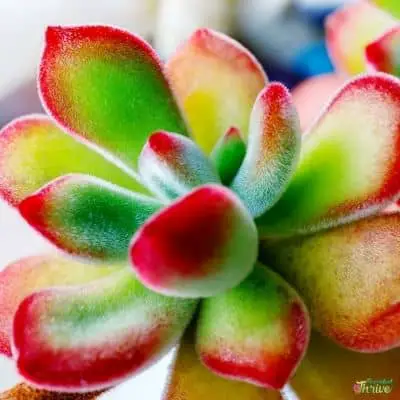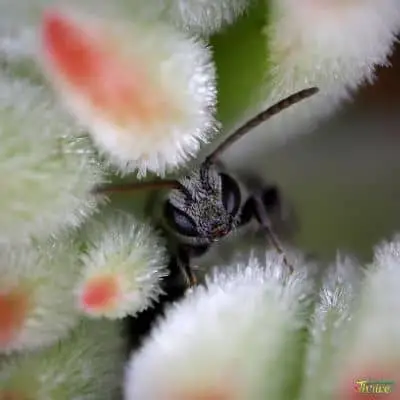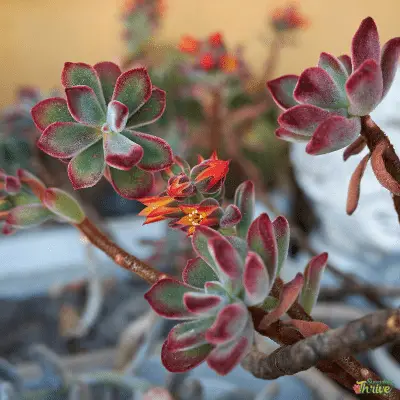The scientific name of the plant is Echeveria Pulvinata ‘Ruby’. The plant is a specially selected variant of an Echeveria species native to Oaxaca, Mexico, Central America, and northwestern South America. The genus of this plant is Echeveria. It is a perennial succulent plant. It belongs to the Crassulaceae family which is easy to grow. There are different common names called Echeveria pulvinata. Such as Chenille Plant plush, Ruby Slippers, Plush Plant, Ruby Blush, Red Velvet, etc.
The leaves of the Echeveria Pulvinata ‘Ruby’ succulent plant are light green with pink to red edges. Each leaf is coated with small white hairs that help to prevent it from drying out. Yellow and orange bell-shaped flowers can be expected as it blooms in the spring. The succulent Echeveria Pulvinata ‘Ruby’ is well-known for its elegance. When fully grown, the plant should be about 15 cm (6′′) tall.
Echeveria Pulvinata ‘Ruby’ succulent plant is a sun-loving plant but, that needs to be protected from harsh winters. However, some environmental stress, such as direct sunlight and temperatures well above zero, brings out the brightest reds around the leaf margins. It’s low-maintenance whether grown in the field or in a jar, as long as it has adequate drainage as well as plenty of sunlight. They’re found in rockeries with other succulents and in pots for terraces and balconies. Floral arrangements are made from the flowers.

Care Data Table of a Echeveria pulvinata?
| Scientific name | Echeveria Pulvinata ‘Ruby’ |
| Common names | Chenille Plant plush, Ruby Slippers, Plush Plant, Ruby Blush, Red Velvet |
| Color – primary | Green / lime |
| Color – secondary | Red / burgundy |
| Bloom color | Orange bloom |
| Growth zone | Zone 9a (Minimum 20° F | -6.7° C) |
| Recommended light conditions | Full sun, bright indoor light |
| Maximum height | 9″-12″ |
| Maximum rosette size | 3″-4″ |
| Growth habit/shape | Vertical grower / tall stem |
| Seasonality | Blooms in fall/winter |
| Product format | 2.0″ pot |
| Special characteristic | Showy blooms, easy to propagate, pet safe |
| dormancy period | Winter |
| Toxicity | Non-toxic to humans and pets |
| Propagation | Stem cuttings and leaves |
How do you take care of a Echeveria pulvinata?
Size
A small shrubby plant that grows to 6 to 12 inches tall and spreads to several feet in width.
Growth
It’s a small shrubby plant that grows to about 12 inches long. The plant has a widespread habits. It grows in the shape of spreading branches with rosettes of fuzzy, fleshy green leaves. The succulent leaves have a pointed tip and are oblong in shape.
Light Requirement
Echeveria Pulvinata ‘Ruby plants can grow in a variety of conditions, from partial shade to full sun. These plants are exposed to maximum sunshine all year in their natural environment, which is why they like bright light. Make sure your plants are in places where they can get lots of good sunshine while still being protected from the hot afternoon sun.
Temperature and humidity
Since their thick leaves help avoid water loss, Echeveria pulvinata plants can withstand high temperatures. However, they prefer mild temperatures and low to moderate humidity. The optimum temperatures for growth are 65 degrees of Fahrenheit to 70 degrees of Fahrenheit (18 degrees of Celsius to 21 degrees of Celsius).
Is it cold hardy?
Echeveria Pulvinata ‘Ruby’ succulent plant is not cold hardy. But, In USDA hardiness zones 9b-11b, the Echeveria Pulvinata ‘Ruby’ succulent plant is winter hardy.
Zone
Zone 9a (Minimum 20 degrees of Fahrenheit | -6.7 degrees of Celsius). (A hardiness zone is a geographically defined region in which, as defined by climatic conditions, a certain type of plant life is able to expand, including its ability to withstand the minimum temperatures of the zone)
Watering Requirement
Echeveria Pulvinata ‘Ruby’ plants dislike being overwatered. Because of the extra moisture, they are resistant to root rot. The soak and dry method is the perfect way to prevent overwatering your Echeveria Pulvinata ‘Ruby’ plant. This is accomplished by watering the plant only when the soil feels dry. You can Maintain this way during the spring and summer. Reduce watering around once a month in the winter. When watering your Echeveria Pulvinata ‘Ruby’ plants, stop watering it from behind or from above the leaves. These plants’ fluffy leaves can hold water, which can allow the leaves to rot.
READ How Often Should I Water My Echeveria Succulent?
Soil Requirement Type / pH
To prevent overwatering, Echeveria pulvinata ruby should be planted in a mildly acidic (pH6.0) and porous soil with well-drained. commercial succulent mix can be used. but if you want to make your own, mix a 2:1 potting soil and coarse sand, or a 1:1:1 potting soil, perlite, and sand.
Flowering and Fragrance
You can see the orange-red flowers in the late winter and early spring. Flower stalks measuring one foot in length emerge first. Following that, racemes of bell-shaped flowers appear.
Read How Do I Get My Echeveria To Bloom?
When grown outdoors, the flowers of Echeveria Pulvinata ‘Ruby’ plant attract pollinators and hummingbirds.
Pot size Potting and Repotting
Plants are 6-9 inches tall when potted, in a 3-inch diameter container. Commercial succulent mix can be used for the potting. But if you want to make your own, mix a 2:1 potting soil and coarse sand, or a 1:1:1 potting soil, perlite, and sand. The warm season is much suitable for repotting the Echeveria Pulvinata ‘Ruby’ succulent plant. soil should be dried before repotting. After that, gently remove the container or pot.
Then, gently remove soil from the roots. You can remove dead roots and rotted roots properly. Cuts should be treated with fungicide. The report can be done.
Where to Plant
Since the Echeveria Pulvinata ‘Ruby’ succulent plant is not cold hardy, it’s safer to grow it in a container that can be taken indoors if you live in a region where the temperature drops below 20 degrees of Fahrenheit (-6.7 degrees of Celsius). It thrives in direct to partial sunlight. Plant in a location in your garden that receives 6 hours of direct sunshine per day. If you’re planting indoors, pick a space with lots of light, such as one with a southern-facing bed.
These hardy succulents prefer mild temperatures and plenty of direct sunshine. In USDA hardiness zones 9b-11b, the Echeveria Pulvinata ‘Ruby’ succulent plant is winter hardy. These tender succulents are best suited to life indoors on a bright sunshine windowsill in lower hardiness areas.
Fertilizer and time of year
Feeding Echeveria Pulvinata ‘Ruby’ plants can be helpful, particularly during the growing season. The growth of the plant should happen during the spring and summer. Feed the plants with a balanced nutrient sparingly in the early spring. When winter arrives, stop eating entirely.
Dormancy
Echeveria Pulvinata ‘Ruby’ develops in the spring and summer and they go dormant in the winter.
Other plants Pairs Well With
Echeveria Pulvinata ‘Ruby’ pairs well with Echeveria ‘Lola’.
Can it be toxic to pets?
Generally, Echeveria Pulvinata ‘Ruby’ plants are not toxic to humans and pets.
Common bugs and illness issues
Echeverias, like other cactus and succulents, are not susceptible to disease or rodents if well cared for. It can remain safe and hardy if you don’t overwater it and keep it in well-draining soil with an adequate amount of sunshine and mild temperatures. rot and fungal infections can be caused due to overwatering. So, please do not overwater the Echeveria Pulvinata ‘Ruby’ plants. you can use a soak and dry method to water the Echeveria Pulvinata ‘Ruby’ plants. Spider mites, fungus gnats, mealybugs, and scale attack plants that have been damaged by bad conditions.

Special Care Tips
It’s important to remember to get rid of any dead leaves from the foundation. You can control root rot and fungal diseases by removing the dead leaves. On the other hand, Pests find dead leaves to be an ideal hiding place. Also, pests can be removed from the plants.
How do you propagate a Echeveria pulvinata?
Echeveria Pulvinata ‘Ruby’ plants can be propagated from the stem cutting or the leaves.
Stem cutting
- Cutting should be done by using a sterile, sharp knife.
- The stem should be removed from the main plant. Then, it should be allowed to callous it for a few days before planting. Planting should be done in well-draining soil.
- Watering should be done after it is completed dry.
Leaves
- Twist a leaf from the mother plant to propagate Echeveria Pulvinata ‘Ruby’ plant from leaves.
- (If some of the leaves stays attached to the stem, you would have a lower chance of success.)
- Leave the leaf to dry out for a few days so the callouses on the end will be over.
- Place on well-draining soil after that.
- When the soil is totally dry, water it.
How do you report an Echeveria pulvinata?
The warm season is much suitable for repotting the Echeveria Pulvinata ‘Ruby’ succulent plant. soil should be dried before repotting. After that, gently remove the container or pot. Then, gently remove soil from the roots. You can remove dead roots and rotted roots properly. Cuts should be treated with fungicide. The report can be done.

Echeveria peperomia plant benefits
- The succulent Echeveria Pulvinata ‘Ruby’ succulent plant quickly becomes one of the most common echeverias among those who grow it.
- This species makes a good groundcover in areas where it is winter hardy.
- In places where Echeveria pulvinata ‘Ruby Succulent plant is not winter hardy, it makes a good container plant for the porch or patio and can be brought indoors for the winter.
- Growing Echeveria pulvinata ‘Ruby’ as a succulent hanging basket plant can be very attractive.
- Red Velvet plants add elegance to the home year-round as the indoor plant.
Credits to Succulent Addict
Is Echeveria pulvinata an indoor plant?
No. Echeveria Pulvinata ‘Ruby’ succulent plant is love to live in direct to partial sunlight.so, if the sun is shining well, the outdoors is the best place to plant ‘Ruby’ succulent plant. but it is not cold and hardy, it’s safer to grow it in a container that can be taken indoors if you live in a region where the temperature drops below 20 degrees of Fahrenheit (-6.7 degrees of Celsius). Is better.
Is Echeveria pulvinata toxic?
No, Pulvinata ‘Ruby’ succulent plant is not toxic to pets or humans
Does Echeveria pulvinata need direct sunlight?
Yes. Pulvinata ‘Ruby’ succulent plant prefers direct sunlight.
How long does it take for Echeveria to grow?
Within about a few weeks, new plants emerge from their own leaves. The duration of this process can vary from a few weeks to several months.
READ Can You Use Ice Cubes To Water Succulents? Must Know
